Investigation of Vertical Profiles of Particulate Matter and Meteorological Variables up to 2.5 km in Altitude Using a Drone-Based Monitoring System
Abstract
1. Introduction
2. Methods
2.1. Particle Measurement Instruments
2.2. Unmanned Aerial Vehicle (UAV) System
2.3. Measurement Site and Strategies
2.3.1. Meteorological Profiles
2.3.2. Vertical Profiles of Particulate Matter
3. Results and Discussion
3.1. Evaluation of Sensor Performance
3.2. Vertical Profile: Anmyeondo
3.3. Vertical Profile: Boseong
3.3.1. Meteorological Parameters
3.3.2. Particle Concentration
3.3.3. Relationship Between RH and Particle Concentration
4. Conclusions
Supplementary Materials
Author Contributions
Funding
Institutional Review Board Statement
Informed Consent Statement
Data Availability Statement
Acknowledgments
Conflicts of Interest
References
- Dockery, D.W.; Pope, C.A., III; Xu, X.; Spengler, J.D.; Ware, J.H.; Fay, M.E.; Ferris, B.G., Jr.; Speizer, F.E. An association between air pollution and mortality in six US cities. N. Engl. J. Med. 1993, 329, 1753–1759. [Google Scholar] [CrossRef]
- Pope, C.A., III; Dockery, D.W. Health effects of fine particulate air pollution: Lines that connect. J. Air Waste Manag. Assoc. 2006, 56, 709–742. [Google Scholar] [CrossRef]
- Dominici, F.; Peng, R.D.; Bell, M.L.; Pham, L.; McDermott, A.; Zeger, S.L.; Samet, J.M. Fine particulate air pollution and hospital admission for cardiovascular and respiratory diseases. JAMA 2006, 295, 1127–1134. [Google Scholar] [CrossRef] [PubMed]
- Harrison, R.M.; Yin, J. Particulate matter in the atmosphere: Which particle properties are important for its effects on health? Sci. Total Environ. 2000, 249, 85–101. [Google Scholar] [CrossRef]
- Zhang, R.; Li, Q.; Zhang, R. Meteorological conditions for the persistent severe fog and haze episode in January 2013 in central-eastern China. Sci. China Earth Sci. 2014, 57, 26–35. [Google Scholar]
- Van Donkelaar, A.; Martin, R.V.; Brauer, M.; Kahn, R.; Levy, R.; Verduzco, C.; Villeneuve, P.J. Global estimates of ambient fine particulate matter concentrations from satellite-based aerosol optical depth: Development and application. Environ. Health Perspect. 2010, 118, 847–855. [Google Scholar] [CrossRef]
- Wang, X.; Bi, X.; Sheng, G.; Fu, J. Chemical composition and sources of PM10 and PM2.5 aerosols in Guangzhou, China. Environ. Monit. Assess. 2006, 119, 425–439. [Google Scholar] [CrossRef] [PubMed]
- Kulmala, M.; Riipinen, I.; Sipilä, M.; Manninen, H.E.; Petäjä, T.; Junninen, H.; Dal Maso, M.; Mordas, G.; Mirme, A.; Vana, M.; et al. Toward direct measurement of atmospheric nucleation. Science 2007, 318, 89–92. [Google Scholar] [CrossRef] [PubMed]
- Li, Y.; Yuan, S.; Fan, S.; Song, Y.; Wang, Z.; Yu, Z.; Li, T.; Chen, X.; Wang, W.; Liu, Y. Satellite remote sensing for estimating PM2.5 and its components. Curr. Pollut. Rep. 2021, 7, 72–87. [Google Scholar] [CrossRef]
- Ma, Y.; Zhu, Y.; Liu, B.; Li, H.; Jin, S.; Zhang, Y.; Hu, W.; Liang, G.; Wang, L.; Gong, W. Estimation of the vertical distribution of particle matter (PM2.5) concentration and its transport flux from lidar measurements based on machine learning algorithms. Atmos. Chem. Phys. 2021, 21, 17003–17016. [Google Scholar] [CrossRef]
- Clarke, A.; Kapustin, V. Hemispheric aerosol vertical profiles: Anthropogenic impacts on optical depth and cloud nuclei. Science 2010, 329, 1488–1492. [Google Scholar] [CrossRef]
- Huebert, B.J.; Bates, T.S.; Russell, P.B.; Shi, G.; Seinfeld, J.H.; Albrecht, B.A.; Kim, Y.J.; Kawamura, K.; Carmichael, G.R.; Nakajima, T. An overview of ACE-Asia: Strategies for quantifying the relationships between Asian aerosols and their climatic impacts. J. Geophys. Res. Atmos. 2003, 108, 8633. [Google Scholar] [CrossRef]
- Singh, H.B.; Brune, W.H.; Crawford, J.H.; Jacob, D.J.; Russell, P.B. Overview of the summer 2004 Intercontinental Chemical Transport Experiment–North America (INTEX-A). J. Geophys. Res. Atmos. 2006, 111, D24. [Google Scholar] [CrossRef]
- Anderson, B.E.; Cofer, W.R.; Crawford, J.; Gregory, G.L.; Vay, S.A.; Brunke, K.E.; Kondo, Y.; Koike, M.; Schlager, H.; Baughcum, S.L.; et al. An assessment of aircraft as a source of particles to the upper troposphere. Geophys. Res. Lett. 1999, 26, 3069–3072. [Google Scholar] [CrossRef]
- Deshler, T. A review of global stratospheric aerosol: Measurements, importance, life cycle, and local stratospheric aerosol. Atmos. Res. 2008, 90, 223–232. [Google Scholar] [CrossRef]
- Hofmann, D.J. Twenty years of balloon-borne tropospheric aerosol measurements at Laramie, Wyoming. J. Geophys. Res. Atmos. 1993, 98, 12753–12766. [Google Scholar] [CrossRef]
- Ansmann, A.; Riebesell, M.; Wandinger, U.; Weitkamp, C.; Voss, E.; Lahmann, W.; Michaelis, W. Combined Raman elastic-backscatter lidar for vertical profiling of moisture, aerosol extinction, backscatter, and lidar ratio. Appl. Phys. B 1992, 55, 18–28. [Google Scholar] [CrossRef]
- Sicard, M.; Pérez, C.; Rocadenbosch, F.; Baldasano, J.M.; García-Vizcaino, D. Mixed-layer depth determination in the Barcelona coastal area from regular lidar measurements: Methods, results and limitations. Bound. Layer Meteorol. 2006, 119, 135–157. [Google Scholar] [CrossRef]
- Winker, D.M.; Hunt, W.H.; McGill, M.J. Initial performance assessment of CALIOP. Geophys. Res. Lett. 2007, 34, L19803. [Google Scholar] [CrossRef]
- Liu, Z.; Omar, A.; Vaughan, M.; Hair, J.; Kittaka, C.; Hu, Y.; Powell, K.; Trepte, C.; Winker, D.; Poole, L.; et al. CALIPSO lidar observations of the optical properties of Saharan dust: A case study of long-range transport. J. Geophys. Res. Atmos. 2008, 113, D07207. [Google Scholar] [CrossRef]
- Wang, J.; Martin, S.T. Satellite characterization of urban aerosols: Importance of including hygroscopicity and mixing state in the retrieval algorithms. J. Geophys. Res. Atmos. 2007, 112, D17105. [Google Scholar] [CrossRef]
- Villa, T.F.; Salimi, F.; Morton, K.; Morawska, L.; Gonzalez, F. Development and validation of a UAV based system for air pollution measurements. Sensors 2016, 16, 2202. [Google Scholar] [CrossRef] [PubMed]
- Altstädter, B.; Platis, A.; Wehner, B.; Scholtz, A.; Wildmann, N.; Hermann, M.; Kästner, U.; Laukert, G.; Bange, J.; Lampert, A. ALADINA–an unmanned research aircraft for observing vertical and horizontal distributions of ultrafine particles within the atmospheric boundary layer. Atmos. Meas. Tech. 2015, 8, 1627–1639. [Google Scholar] [CrossRef]
- Kim, N.G.; Jeong, S.B.; Jin, H.C.; Lee, J.; Kim, K.H.; Kim, S.; Park, Y.; Choi, W.; Kwak, K.H.; Lee, H.; et al. Spatial and PMF analysis of particle size distributions simultaneously measured at four locations at the roadside of highways. Sci. Total Environ. 2023, 893, 164892. [Google Scholar] [CrossRef] [PubMed]
- Moreno, T.; Reche, C.; Ahn, K.H.; Eun, H.R.; Kim, W.Y.; Kim, H.S.; Fernández-Iriarte, A.; Amato, F.; Querol, X. Using miniaturised scanning mobility particle sizers to observe size distribution patterns of quasi-ultrafine aerosols inhaled during city commuting. Environ. Res. 2020, 191, 109978. [Google Scholar] [CrossRef]
- Barrientos, A.; Colorado, J.; Cerro, J.D.; Martinez, A.; Rossi, C.; Sanz, D.; Valente, J. Aerial remote sensing in agriculture: A practical approach to area coverage and path planning for fleets of mini aerial robots. J. Field Robot. 2011, 28, 667–689. [Google Scholar] [CrossRef]
- Tomaštík, J.; Mokroš, M.; Surový, P.; Grznárová, A.; Merganič, J. UAV RTK/PPK method—An optimal solution for mapping inaccessible forested areas? Remote Sens. 2019, 11, 721. [Google Scholar] [CrossRef]
- Watts, A.C.; Ambrosia, V.G.; Hinkley, E.A. Unmanned aircraft systems in remote sensing and scientific research: Classification and considerations of use. Remote Sens. 2012, 4, 1671–1692. [Google Scholar] [CrossRef]
- Anderson, K.; Gaston, K.J. Lightweight unmanned aerial vehicles will revolutionize spatial ecology. Front. Ecol. Environ. 2013, 11, 138–146. [Google Scholar] [CrossRef]
- Crilley, L.R.; Shaw, M.; Pound, R.; Kramer, L.J.; Price, R.; Young, S.; Lewis, A.C.; Pope, F.D. Evaluation of a low-cost optical particle counter (Alphasense OPC-N2) for ambient air monitoring. Atmos. Meas. Tech. 2018, 11, 709–720. [Google Scholar] [CrossRef]
- Hwang, I.; Ahn, K.H. Performance evaluation of conventional type conductive cooling continuous flow compact water-based CPC (Hy-WCPC). J. Aerosol Sci. 2017, 113, 12–19. [Google Scholar] [CrossRef]
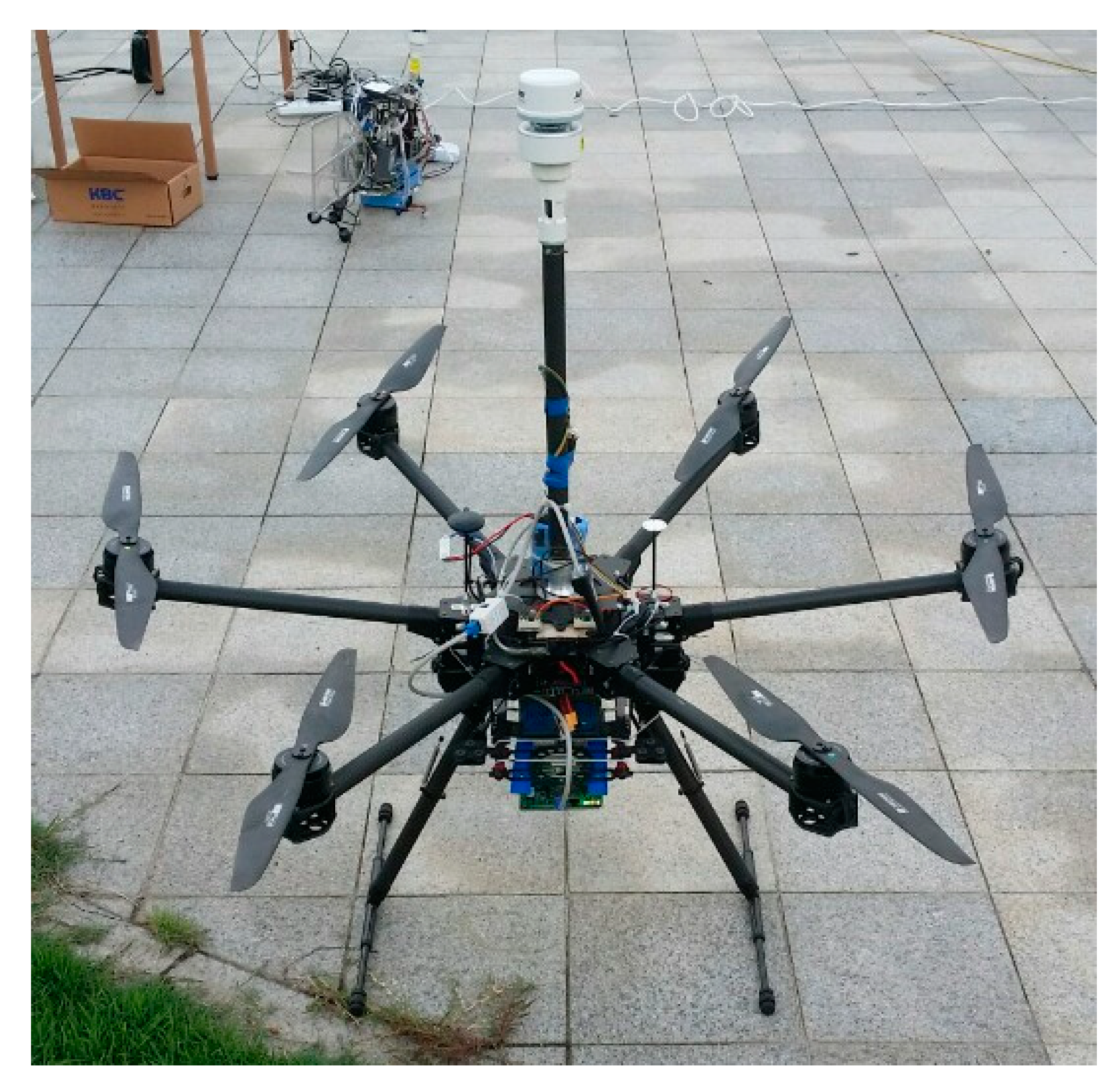

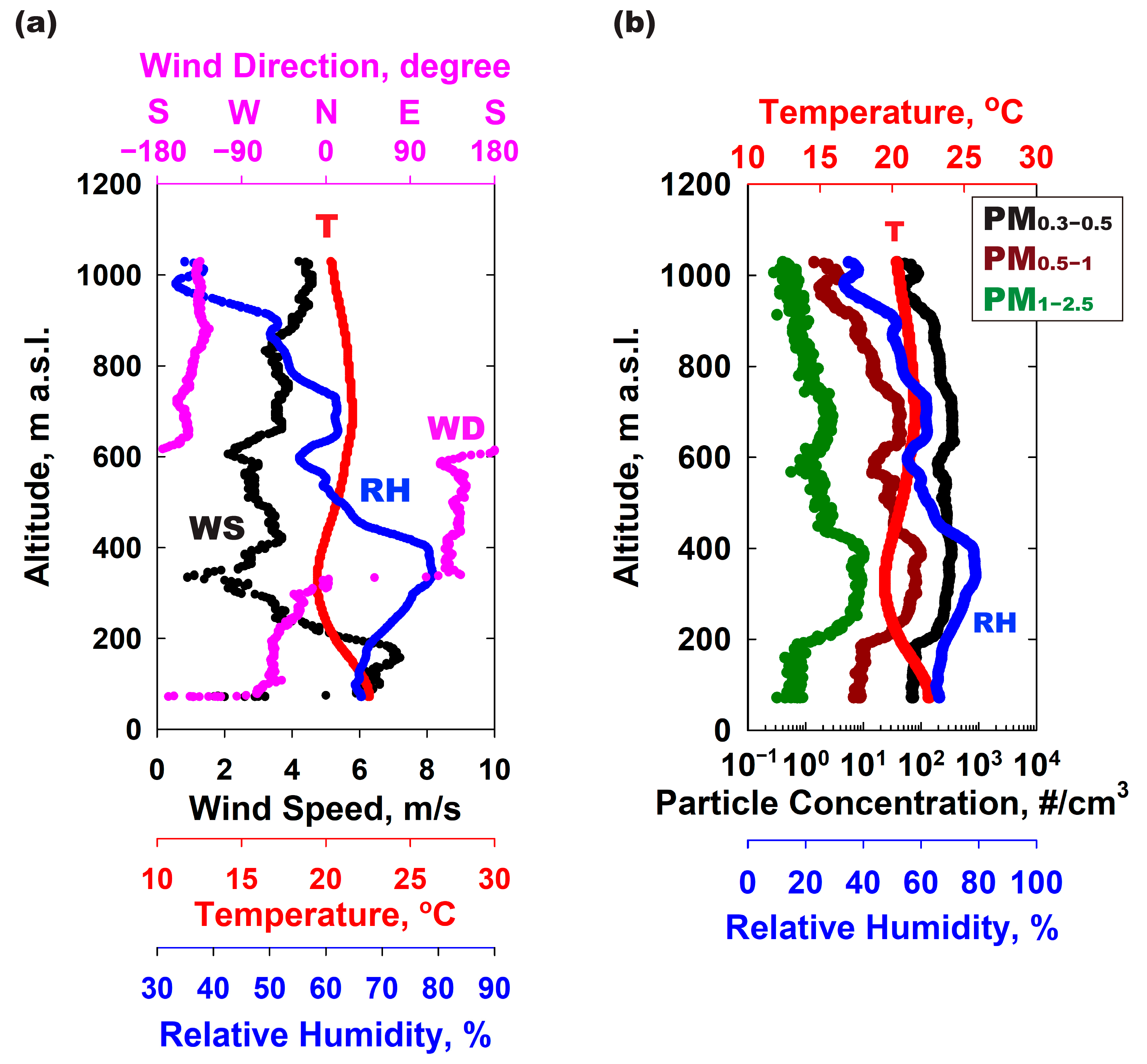
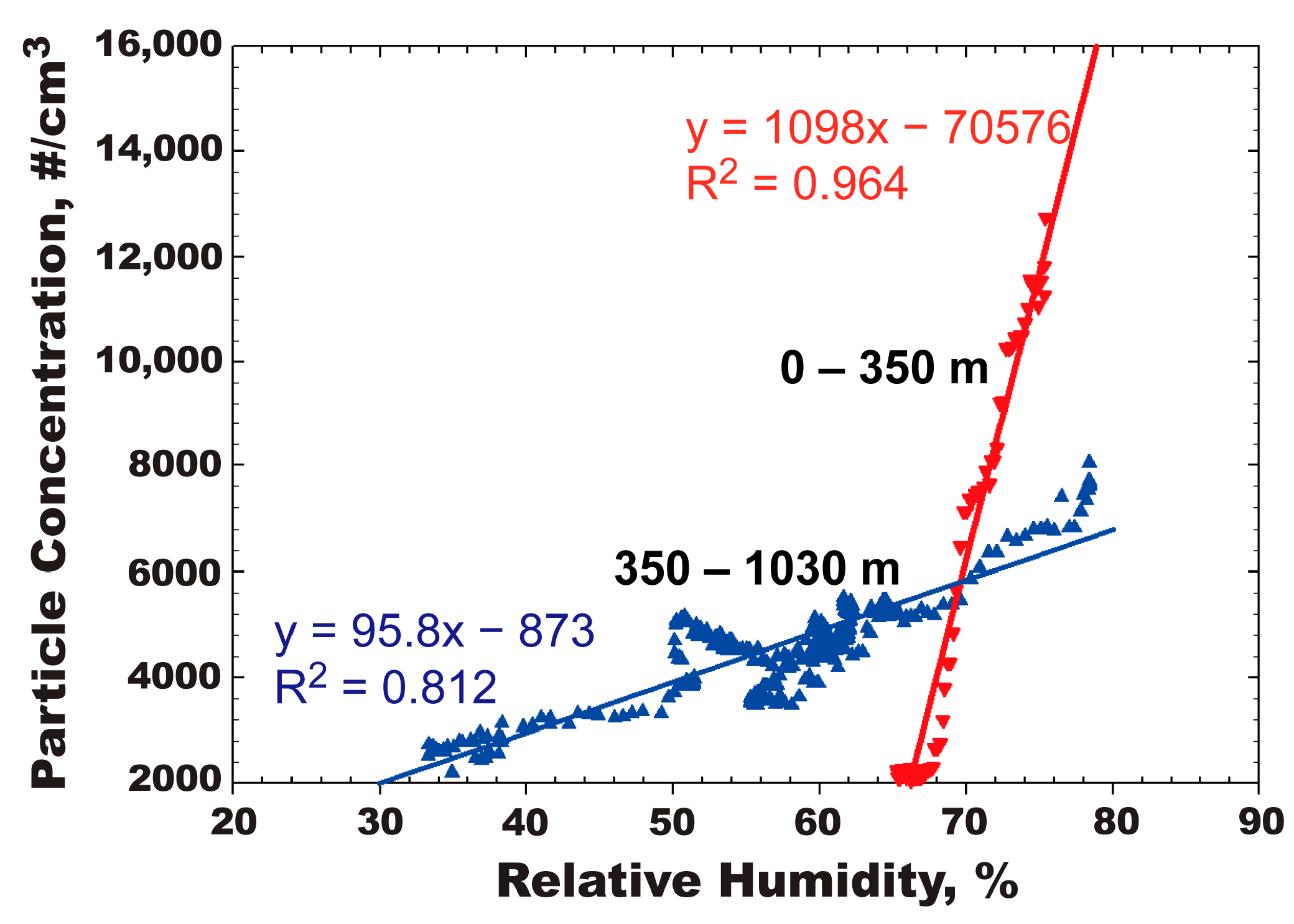
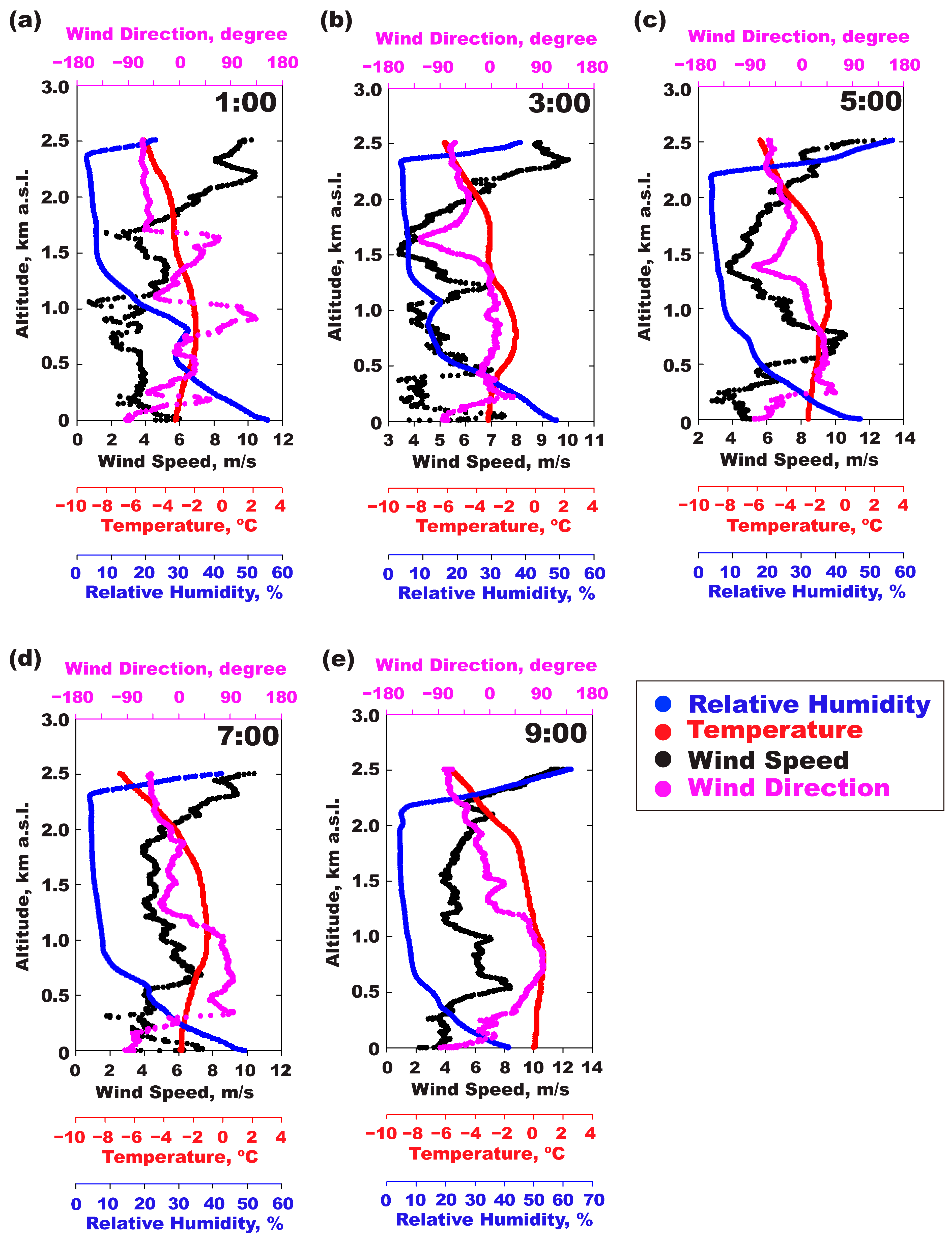
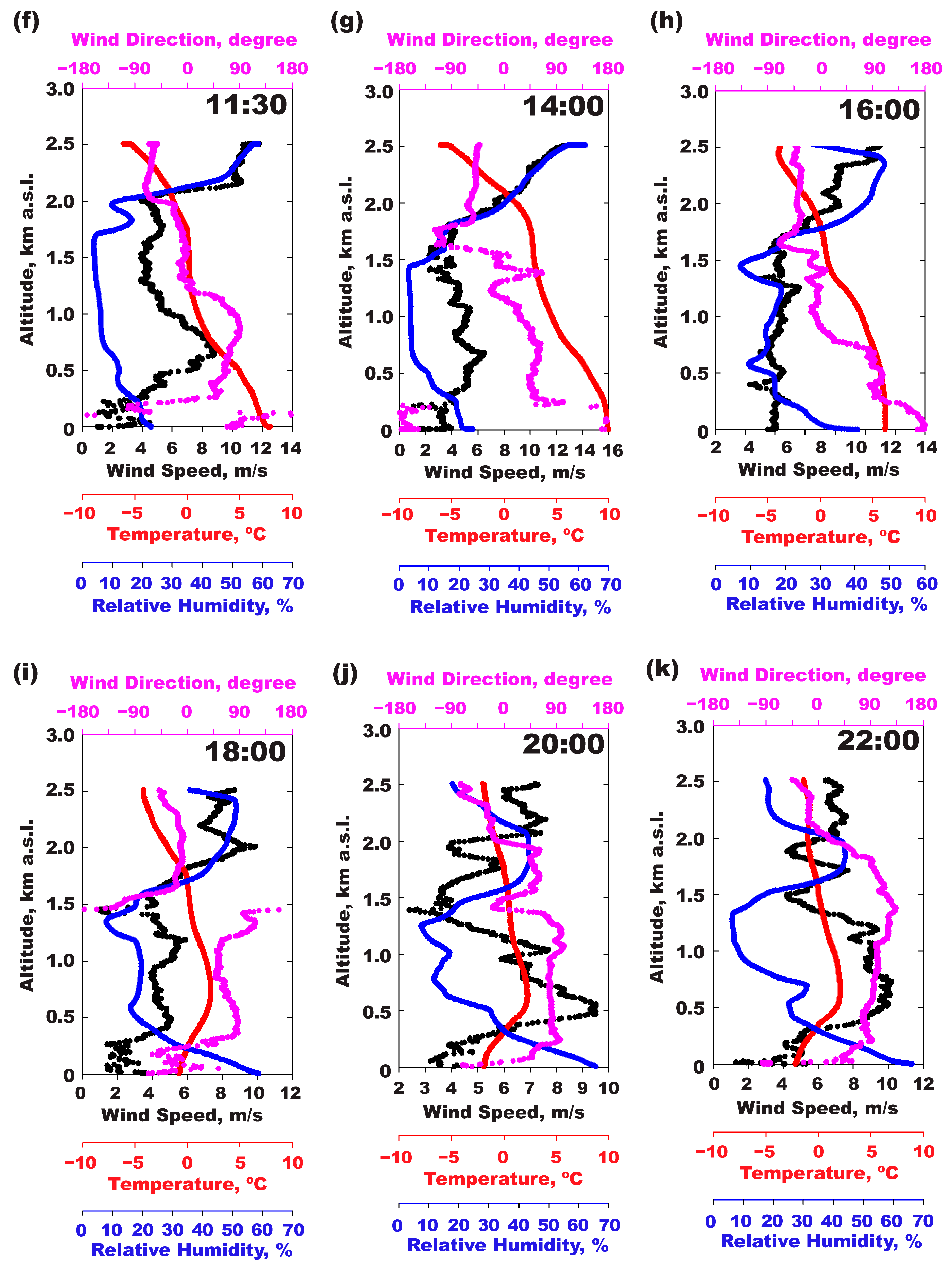
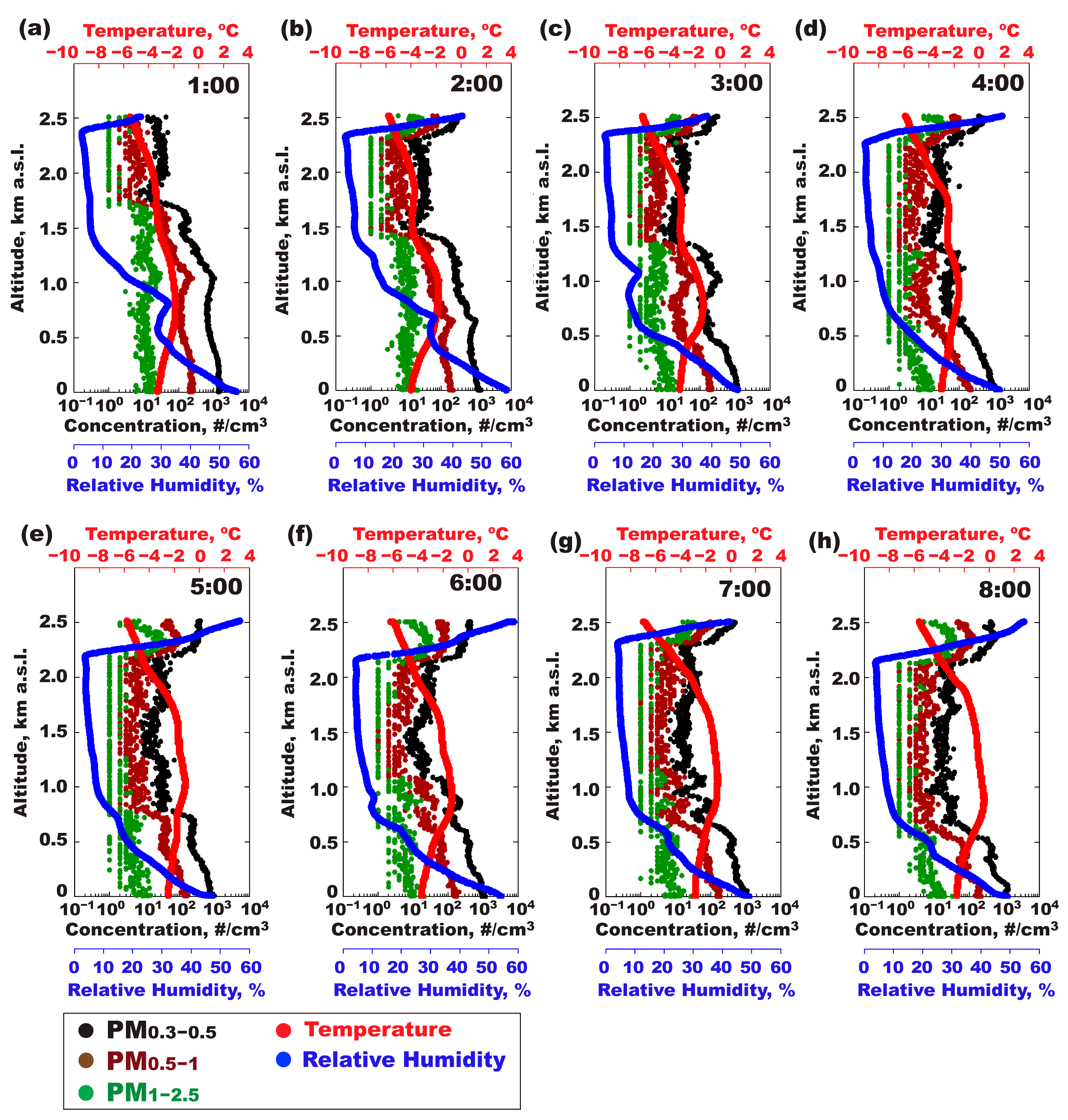
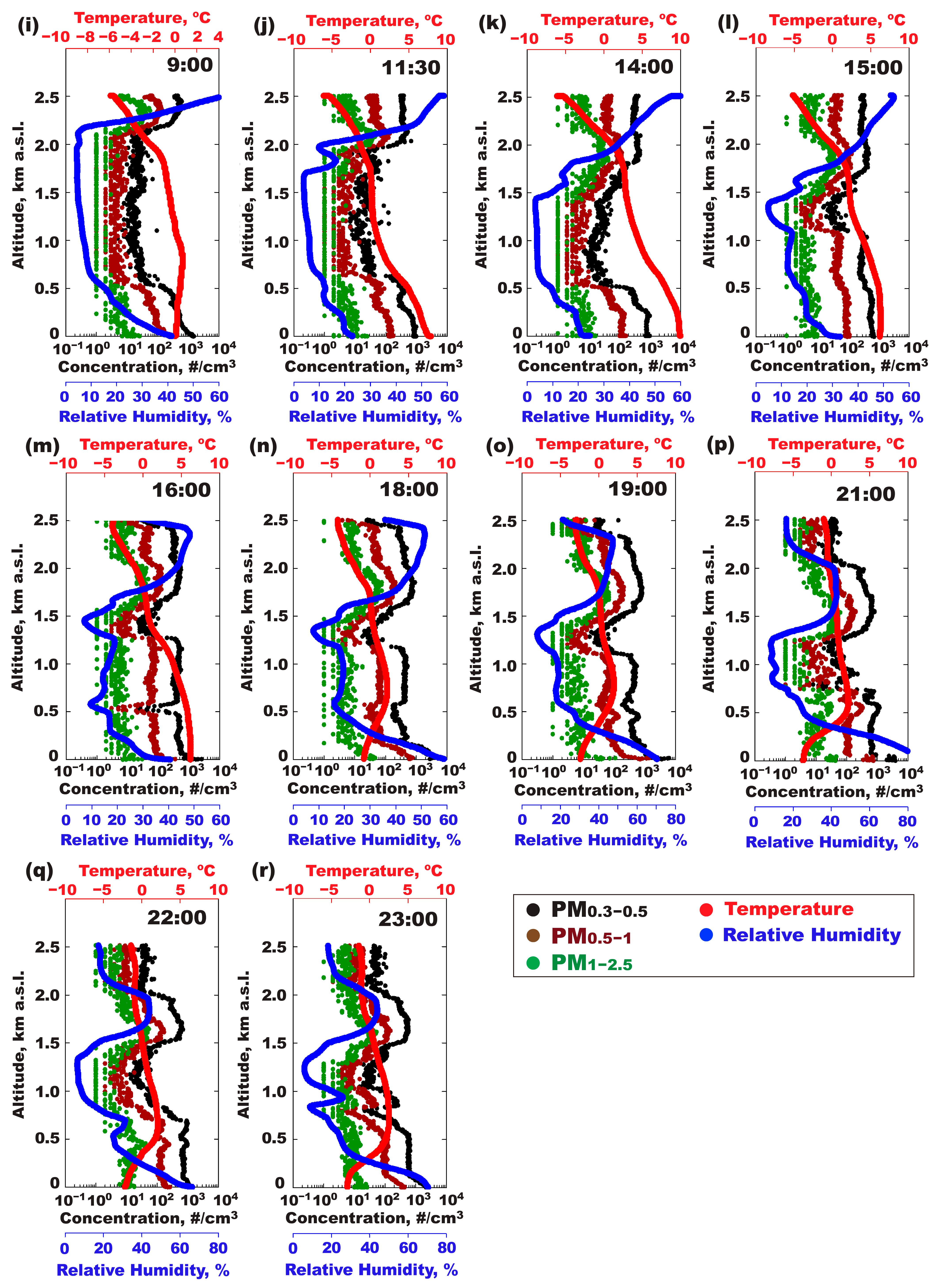

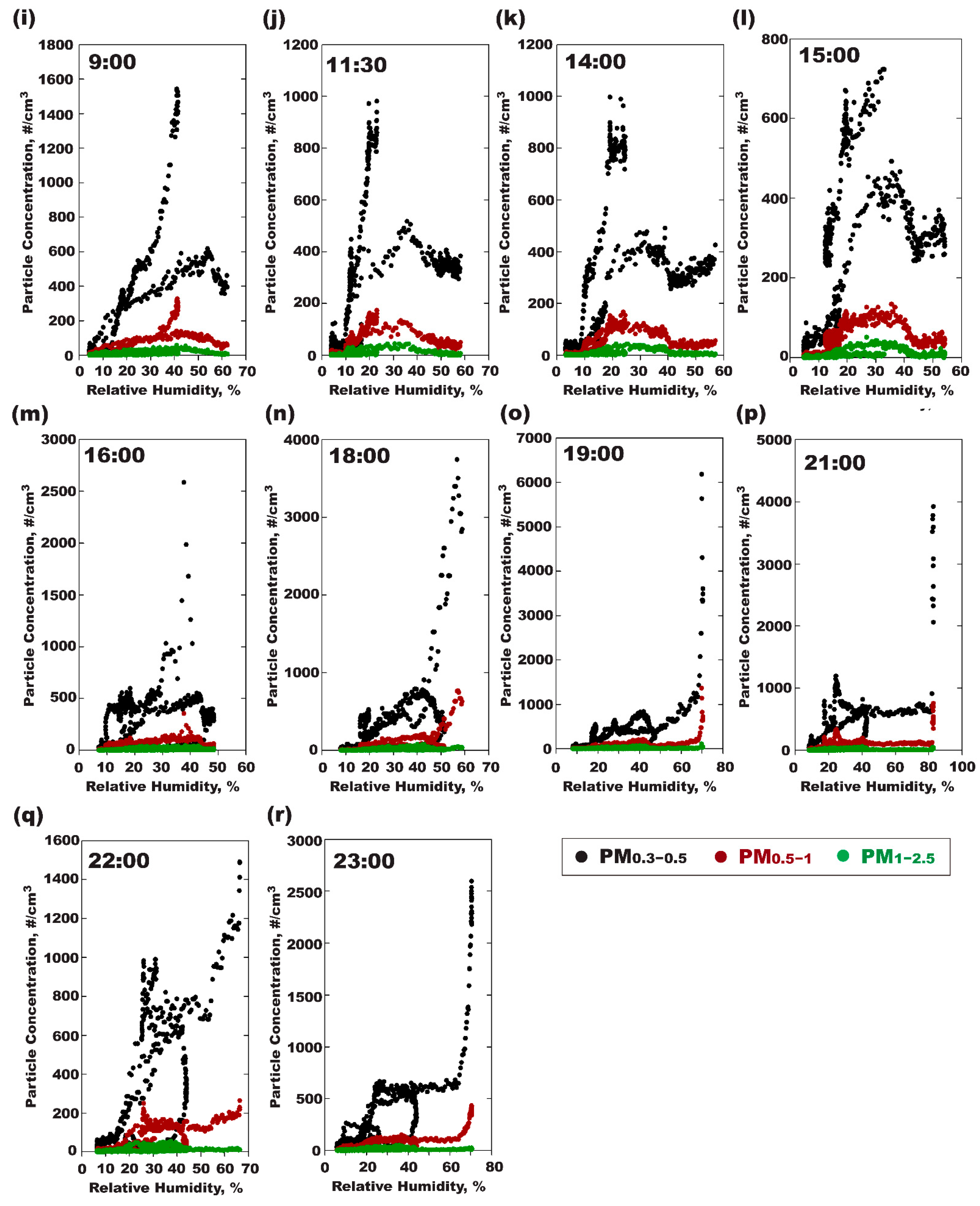
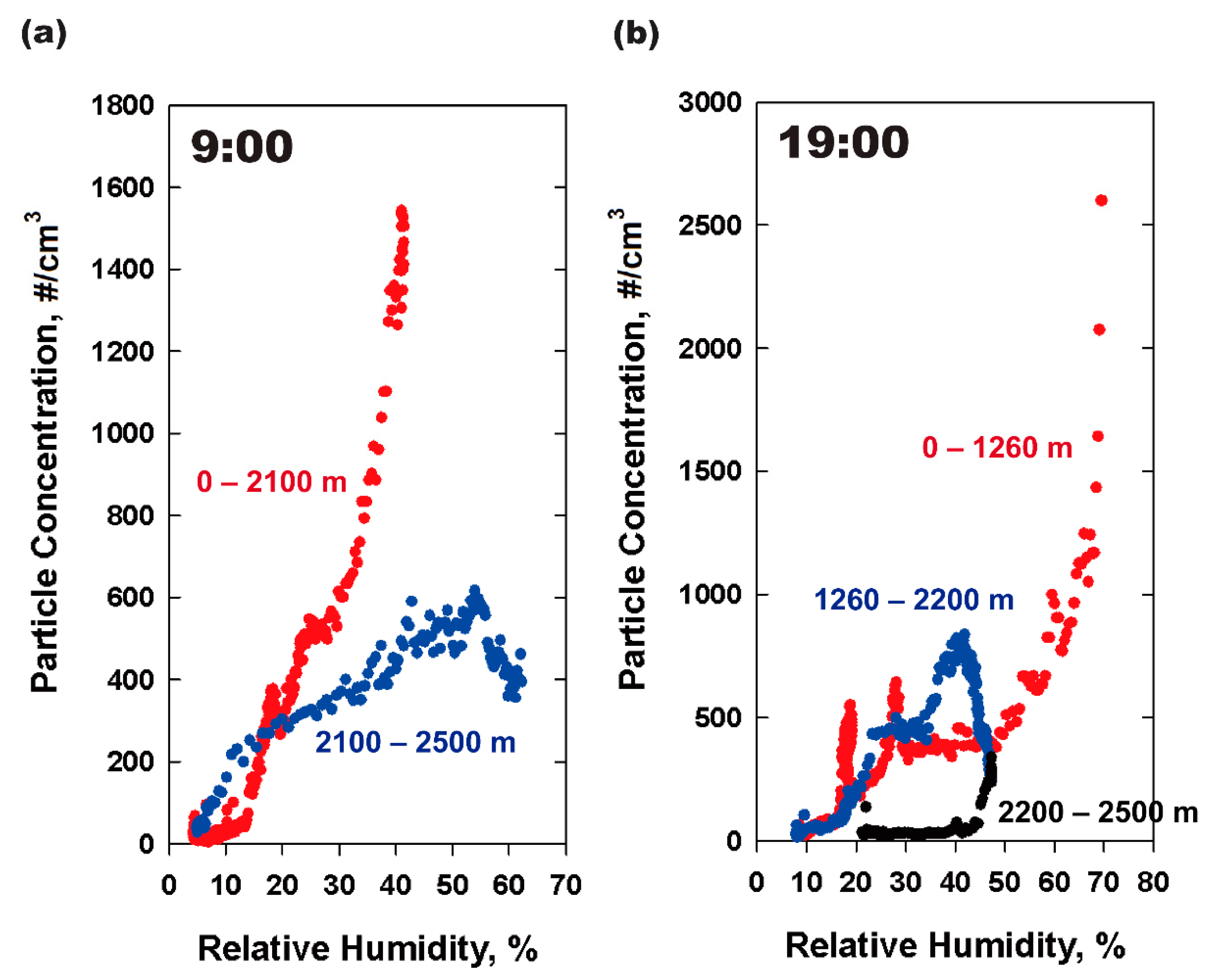
Disclaimer/Publisher’s Note: The statements, opinions and data contained in all publications are solely those of the individual author(s) and contributor(s) and not of MDPI and/or the editor(s). MDPI and/or the editor(s) disclaim responsibility for any injury to people or property resulting from any ideas, methods, instructions or products referred to in the content. |
© 2025 by the authors. Licensee MDPI, Basel, Switzerland. This article is an open access article distributed under the terms and conditions of the Creative Commons Attribution (CC BY) license (https://creativecommons.org/licenses/by/4.0/).
Share and Cite
Kim, W.Y.; Lee, S.G.; Lee, H.; Ahn, K.-H. Investigation of Vertical Profiles of Particulate Matter and Meteorological Variables up to 2.5 km in Altitude Using a Drone-Based Monitoring System. Atmosphere 2025, 16, 93. https://doi.org/10.3390/atmos16010093
Kim WY, Lee SG, Lee H, Ahn K-H. Investigation of Vertical Profiles of Particulate Matter and Meteorological Variables up to 2.5 km in Altitude Using a Drone-Based Monitoring System. Atmosphere. 2025; 16(1):93. https://doi.org/10.3390/atmos16010093
Chicago/Turabian StyleKim, Woo Young, Sang Gu Lee, Handol Lee, and Kang-Ho Ahn. 2025. "Investigation of Vertical Profiles of Particulate Matter and Meteorological Variables up to 2.5 km in Altitude Using a Drone-Based Monitoring System" Atmosphere 16, no. 1: 93. https://doi.org/10.3390/atmos16010093
APA StyleKim, W. Y., Lee, S. G., Lee, H., & Ahn, K.-H. (2025). Investigation of Vertical Profiles of Particulate Matter and Meteorological Variables up to 2.5 km in Altitude Using a Drone-Based Monitoring System. Atmosphere, 16(1), 93. https://doi.org/10.3390/atmos16010093





